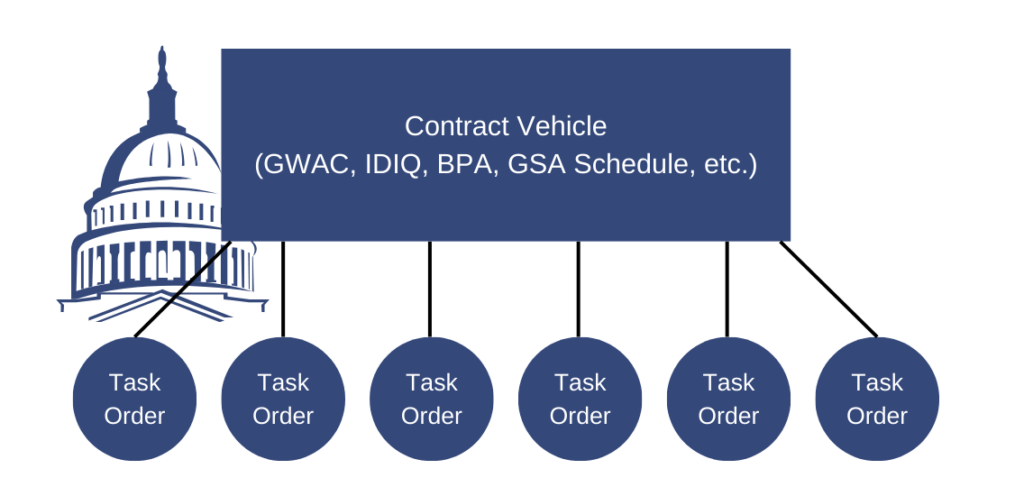If you’re navigating the world of government contracting, you’ve likely heard the term task order thrown around quite a bit.
So, exactly what is a Task Order in Government Contracting? And how does it differ from a contract vehicle?
Simply put, a task order is an order for specific services or goods issued against an established contract vehicle – often under Indefinite Delivery/Indefinite Quantity (IDIQ) contracts, Government-Wide Acquisition Contracts (GWACs), or Blanket Purchase Agreements (BPAs).
Think of a contract vehicle (IDIQ, BPA, GWAC, or GSA Schedule) as a large contract with the government. You sign the contract with the government, agreeing to rates, terms and conditions, but there isn’t any work at this contract level. The real work is purchased on the task orders issued under that contract.

Contract Vehicles
Here’s how it works. The government puts out an IDIQ, GWAC, or BPA initially for bid or allows vendors to onramp to it over time. These are called contract vehicles.
Contract vehicles allow the government to put out similar kinds of work out for bid to a limited pool of vendors. For our purposes, the work is usually technology or professional services related. For instance, CIOSP4 and T4NG2 are essentially technology contracts. STARS III is limited to small businesses with an 8a socio-economic set-aside. The Centers for Medicare and Medicaid has an IDIQ called RMADA, mainly for research. Even the GSA Multiple Award Schedule (MAS) has specific SINS (Special Item Number) in order to categorize products or services for government buyers.
There are basic requirements for getting on these contract vehicles. Usually, the contractor has to show that they have the capabilities to deliver the work expected to come out of the vehicles and that they have the past performance or corporate experience to demonstrate that they can do the work successfully if awarded.
Additionally, the contractor will also submit rates for predefined labor categories.
Contract vehicles allow the government to put out a specific scope of work as a Task Order (e.g., build an IT system to allow veterans to book online appointments) to a smaller list of vendors they know should be able to do the job.
This smaller list of vendors are already companies that the government has evaluated as having a) capabilities to do this kind of work b) past performance to show they will probably be successful and c) rates the government has deemed to be fair and reasonable.
It is important to note that all contract expenditures on contract vehicles happen through the task orders. The contract vehicle itself does not represent any revenue to the company. This is why most companies call these contract vehicles merely “hunting licenses”. The real work begins AFTER you win a contract vehicle.
Task Orders
Task orders are a vital tool in the government’s procurement process. They allow agencies to move quickly and efficiently to address their needs without going through the lengthy and often complicated full competitive bidding process each time they need a new service or product.
Here’s a closer look at some of the key features that make task orders so essential:
- Scope: Every task order outlines the scope of work, deliverables, pricing, and the timeline for doing the work known as the “period of performance”. For information technology and professional services contracts, this scope is generally outlined in one of three ways:
- Statement of Work
- Statement of Objectives
- Performance Work Statement
- Efficiency: By leveraging existing contract vehicles, with prescreened vendors, task orders cut through red tape, allowing the government to get solutions faster.
- Flexibility: Government priorities change, and so does funding. Task orders allow agencies to pivot and adapt to new needs without renegotiating entire contract vehicles with new rates, terms and conditions.
Types of Task Orders
There are two main types of task orders, each offering different advantages depending on the situation:
- Competitive Task Orders: These are issued under multiple-award contracts where several contractors compete for each task order. Think of it as mini-competitions under a larger umbrella contract.
- Sole Source (or Direct) Task Orders: Sometimes, agencies need a specific set of services or capabilities that only one contractor can provide. In these cases, they’ll issue a task order directly to a single contractor under a single-award contract.
How the Task Order Process Works
The task order process, like any procurement method, follows a series of steps:
- Identifying the Requirement: The government agency identifies what it needs.
- Developing the Task Order: The task order is created, specifying all the details like scope, timeline, and cost.
- Market Research: The government may prefer to do market research among the pool of vendors capable fo doing this work. This market research could begin as a Sources Sought Notice or Request for Information (RFI) and it could be followed up with conversations with vendors who have submitted compelling market research responses. One result of this market research is the government could decide to put the task order out on a particular contract vehicle in order to reach the types of vendors they are looking to reach.
- Solicitation: This is where interested contractors submit their proposals for competitive task orders.
- Evaluation and Award: The government reviews the proposals and awards the task order.
- Performance and Management: This is where contractors are executing the work while the government manages and monitors progress.
Legal and Regulatory Considerations
A task order must align with the terms of the original contract. For instance, the government can’t put out a task order asking vendors to bid to build a submarine on a contract vehicle focused on IT services. This is an over-exaggeration, but you get the point.
Also, keep in mind that the government is only liable for costs authorized under a fully executed task order. Contractors must propose how they plan to deliver, including pricing and timelines, and the Contracting Officer’s signature makes everything official.
Task Order vs Traditional Contracts
Task orders differ from traditional contracts in several key ways:
Flexibility and Efficiency
Task orders offer greater flexibility and efficiency compared to traditional contracts:
- They allow agencies to quickly address needs without going through a full competitive bidding process for each requirement
- Agencies can respond to changing priorities and funding availability more easily.
Contract Structure
- Task orders are issued under an existing overarching contract, typically an Indefinite Delivery/Indefinite Quantity (IDIQ) contract, Government-Wide Acquisition Contract (GWAC), or Blanket Purchase Agreement (BPA).
- Traditional contracts are standalone agreements negotiated for specific goods or services.
Scope and Specificity
- Task orders specify work to be performed within the scope of the existing contract, including deliverables, timelines, and pricing.
- Traditional contracts typically define all terms and conditions upfront for the entire project or procurement.
Competition
- For multiple-award contracts, task orders may involve a streamlined competitive process among pre-qualified contractors.
- Traditional contracts often require a full competitive bidding process open to all potential vendors.
Timing and Duration
- Task orders can be issued throughout the period of performance of the overarching contract.
- Traditional contracts have a fixed period of performance established at the outset.
Financial Obligation
- The government is only liable for labor hours and costs authorized by a fully executed task order.
- Traditional contracts often involve a more significant upfront financial commitment.
Adaptability
Task orders allow for greater adaptability:
- They can be used for new, ongoing, or repeatable services.
- Changes to task order requirements typically require a formal modification by the Contracting Officer.
How does the bidding process for task orders differ from standalone contracts?
The bidding process for task orders differs from standalone contracts in several key ways:
Limited Competition
- As mentioned above when we talked about contract vehicles, task orders are competed among a pre-selected pool of contractors who have already been awarded the overarching contract vehicle based on their capabilities and past performance or corporate experience.
- Standalone contracts are often open to ALL qualified bidders through a full competitive bidding process.
Streamlined Process
- Task order competitions are usually more streamlined and faster than full contract competitions.
- The government can quickly solicit proposals from eligible contractors without going through a lengthy procurement process.
Proposal Requirements
- Because the government has essentially already prescreened contractors for the contract vehicle, task order proposals are often shorter and more focused on the specific work to be performed.
- Standalone contract proposals tend to be more comprehensive, covering broader capabilities and past performance.
Evaluation Criteria
- Most of the time, but not always, task order evaluations focus more on the proposed technical approach and pricing for the specific requirement as opposed to the corporate experience and capabilities of the contractor. However, this isn’t always the case because while the contract vehicle might have only been evaluating a broader swath of capabilities (e.g can the contractor build an IT system), the task order evaluation might be more specific (e.g. can the contractor build a user facing system that incorporate HCD and follows a model–template–views architectural pattern used in Django).
Turnaround Time
- Task order proposals typically have shorter turnaround times for submission compared to standalone contracts.
- This requires contractors to be more agile in developing and submitting proposals.
Pricing Structure
- Task order pricing is often based on pre-established labor categories and rates from the base contract vehicle (often the government will ask for additional discounts off the rates listed in the contract vehicle).
- Standalone contracts may involve more complex pricing negotiations.
Scope Limitations
- Task orders must fall within the scope of the overarching contract vehicle.
- Standalone contracts define their scope of work without such limitations.
How does the competition level differ between task orders and standalone contracts?
The competition level for task orders differs significantly from standalone contracts in several key ways:
Limited Pool of Competitors
- Task orders are competed among a pre-selected group of contractors who have already been awarded the overarching contract (e.g., IDIQ, GWAC).
- Standalone contracts are typically open to all qualified bidders in the market.
This limited pool for task orders reduces the number of potential competitors, potentially increasing a contractor’s chances of winning, especially on contract vehicles that only have a handful of contractors on it.
Increased Competition Within the Pool
While the overall number of competitors is reduced for task orders, the competition among the pre-qualified contractors can be intense:
- Contractors in the pool are typically well-vetted and capable of performing the work.
- The streamlined process allows for more frequent competitions, increasing the overall competitive pressure.
Familiarity with Requirements
- Contractors competing for task orders often better understand the agency’s needs and expectations due to their experience with the overarching contract.
- This can lead to more targeted and competitive proposals compared to standalone contracts, where bidders may be less familiar with the agency.
Evaluation Focus
- Task order evaluations tend to focus more on the specific technical approach and pricing for the requirement.
- Standalone contract evaluations may emphasize overall corporate capabilities and past performance.
Protest Thresholds
Task orders have higher thresholds for protests, which can affect competition (and benefit agencies).
- Contractors cannot protest task order awards under $10 million for civilian agencies and under $25 million for Department of Defense agencies.
- This reduced risk of protests can make the competitive environment more straightforward for task orders compared to standalone contracts.
What Contractors Should Keep in Mind about Task Orders
For contractors, task orders present incredible opportunities but also unique challenges. To win and successfully complete a task order, you’ll need to:
- Deeply understand your client’s needs, their pain points and their vision for the future.
- Showcase efficiency, innovation, and performance.
- Maintain a stellar track record of execution and performance on task orders to compete effectively for future opportunities on the contract vehicle.
In Conclusion
Contract vehicles and task orders are the lifeblood of government contracting. They provide a flexible, efficient, and responsive way for agencies to procure the services and goods they need, while also creating a pipeline of opportunities for contractors.

